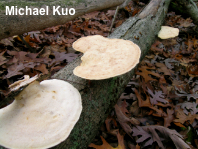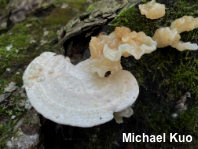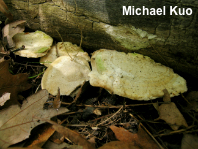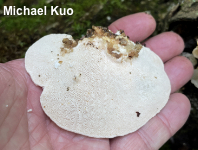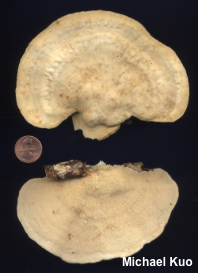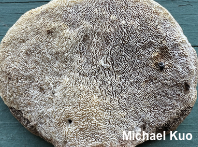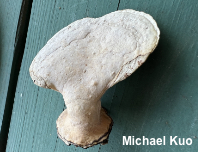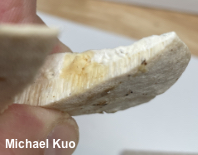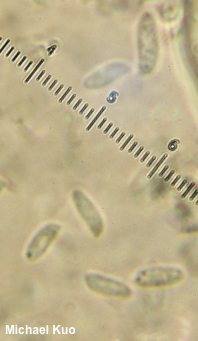| Major Groups > Polypores > Trametes species 01 |

|
[ Basidiomycota > Polyporales > Polyporaceae > Trametes . . . ] Trametes species 01: "aesculi" by Michael Kuo, 28 March 2023 Identifying features for this common, hardwood-loving polypore include its proportionally thin stature, its generally bald cap surface, and the tendency of its pore surface to be either poroid or maze-like. The flesh is white and tough (leathery-tough, not woody-tough), and turns yellow to orange with a drop of KOH. The odor is often, but not always, strong and fragrant. Similar mushrooms include Daedaleopsis confragosa, which is usually more brown and features a red-bruising pore surface, as well as a black reaction to KOH—end, especially, Trametes gibbosa, which is usually thicker, usually more velvety, and usually features pores that are more "slot-like" than "maze-like." If you are annoyed by the "usuallies," I apologize. But there is enough overlap in these features that separating the two species can be difficult. Spore size is more definitive (in Trametes species 01 most spores exceed 5 µm in length, while Trametes gibbosa features spores 4–5 µm long), but polypore microscopy is a pain in the butt rot. Your field guide to North American mushrooms probably calls this mushroom "Trametes elegans," but molecular results from Carlson and collaborators (2014) indicate your guide is likely combining two species—Trametes gibbosa and the one featured here—under the name of a tropical species (Trametes elegans) that does not occur in North America. Carlson and collaborators attempted to revive an older species name, aesculi, to apply to the second North American species, but unfortunately neglected to provide a complete reference (year, page number, etc.) for the original publication, which must be done according to the rules for naming and combining species; "Trametes aesculi" is therefore an invalid name for the mushroom described here—at least, until the error is corrected. Thanks to Crystal Davidson for teaching me this mushroom. Description: Ecology: Saprobic on the deadwood of hardwoods; annual or occasionally perennial; causing a white rot of the sapwood; growing alone or gregariously on logs and stumps; spring through fall; originally described from North Carolina (Schweinitz 1828); precise distribution unclear due to conflation with Trametes gibbosa (see the discussion above), but possibly widely distributed from the Great Plains eastward. The illustrated and described collections are from Illinois and Ohio. Cap: 5–12 cm across; 3–6 cm deep; up to 2 cm thick, but usually 1–1.5 cm thick; semicircular, irregularly bracket-shaped, or kidney-shaped; planoconvex, plane, or planodepressed; dry or moist; bald or, more rarely, finely velvety in places; often with vague concentric zones of texture; whitish to buff or yellowish (sometimes greenish to green in places due to algae); sometimes developing brownish spots or discolorations. Pore Surface: Whitish to yellowish; variable, ranging from poroid with round to angular pores (1–3 per mm), to maze-like, with pores up to 2 mm wide—to slot-like, tooth-like, or even gill-like (often with several types present in the same mushroom); tubes 1–6 mm deep (per annual layer); not bruising. Stem: Absent, or present as a stubby lateral structure with a surface like that of the cap. Flesh: Whitish; very tough and leathery; not changing when sliced. Odor: Usually strong and fragrant when fresh, but sometimes not distinctive. Chemical Reactions: KOH yellow to orange on flesh. Spore Print: White. Microscopic Features: Spores 5–8 x 1.5–2.5 µm; cylindric to long-ellipsoid; smooth; hyaline in KOH; inamyloid. Cystidia not found. Setae not found. Hyphal system trimitic: generative hyphae 2.5–5 µm wide, thin-walled, with clamp connections; skeletal hyphae 5–8 µm wide, thick-walled, aseptate; binding hyphae about 5 µm wide, thick-walled, aseptate, branching frequently. REFERENCES: (E. M. Fries, 1828) A. Justo, 2014. (Overholts, 1953; Gilbertson & Ryvarden, 1987; Tomsovsky et al., 2006; Kout & Vlasak, 2007; Justo & Hibbett, 2011; Carlson et al., 2014; Kuo & Methven, 2014; Zhou et al., 2016; Baroni, 2017; Woehrel & Light, 2017; Elliott & Stephenson, 2018.) Herb. Kuo 10290401, 04280704, 07162203, 07282208. This site contains no information about the edibility or toxicity of mushrooms. |
© MushroomExpert.Com |
|
Cite this page as: Kuo, M. (2023, March). Trametes species 01. Retrieved from the MushroomExpert.Com Web site: http://www.mushroomexpert.com/trametes_species_01.html |
